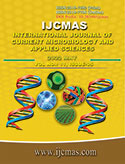


 National Academy of Agricultural Sciences (NAAS)
National Academy of Agricultural Sciences (NAAS)

|
PRINT ISSN : 2319-7692
Online ISSN : 2319-7706 Issues : 12 per year Publisher : Excellent Publishers Email : editorijcmas@gmail.com / submit@ijcmas.com Editor-in-chief: Dr.M.Prakash Index Copernicus ICV 2018: 95.39 NAAS RATING 2020: 5.38 |
Pseudomonas aeruginosa is an opportunistic pathogen causing severe life threatening diseases and continues to be an important cause of nosocomial infections. Virulence mechanisms of Ps. aeruginosa, which causes various types of infections are regulated by quorum sensing. Due to emergence spreading of antimicrobial resistance nowadays. Many researches are focused on the use of compounds targeting Qs that are considered to be a new treatment approach for blocking communication between bacteria and reducing virulence, resulted in improving infection control. In this study, some weak acids including lactic, ascorbic, citric and benzoic acids were selected to evaluate their antimicrobial and antivirulence activities at sub-MICs values on our tested isolates. Our results revealed that both lactic and ascorbic acids affected most tested virulence factors. Specifically, lactic acid showed highly significant effect (P-value < 0.001) on virulence factors of Ps. aeruginosa than ascorbic acid. The effect of lactic acid on the level of expression of quorum sensing encoding genes (lasI, lasR, rhII and rhIR) of two selected Ps. aeruginosa isolates was evaluated using RT-PCR. Interestingly, lactic acid was shown to down-regulate expression of genes involved in the control of pseudomonas QS and the decline expression values reached up to 89% in both tested isolates.
 |
 |
 |
 |
 |